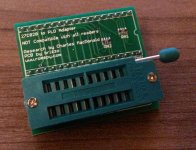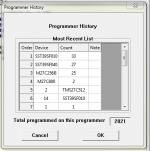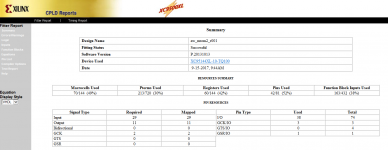Several projects I've been following and even a few of my own recent projects have necessitated me getting a PAL made. I'd like to know more about what's actually going on in these and maybe get enough understanding so that I can work with them myself.
It's my understanding that a PAL/GAL etc. is just a custom logic array. This is what I THINK I understand so far, please let me know if any of this is wrong or misguided.
I'm guessing these are typically used to modify the data buses on the PCB so when ROM swapping say a CPS2 game you may need a different PAL because it will direct the data to different locations on the ROMs? (please let me know if this is correct). And that these are sometimes used as a form of security since the logic used can be difficult to extract and without it it can be difficult to determine how things are routed.
I'm also assuming that micro-controllers are usually used for this task? or does this vary?
Looking around MAME source I really don't see much mention of PALs specifically, sometimes if there is a PCB layout diagram the PAL will be identified but that seems to be it, unless there is some other term or name used that I'm not aware of, or maybe I'm looking in the wrong place? So how are these emulated in MAME? or is it simply not needed due to how the ROMs are mapped? If this is the case is it possible to modify a ROM set to work with a different PAL? (am I correct in assuming this is part of what is done with the ROMs on the multis)
Finally what is needed to build my own PAL/GALs? is there enough info in MAME to build them or do you have to rely on dumps/reverse engineered versions outside of MAME?
I realize there are a lot of questions here but in my search for answers I got even more questions than answers. Any info that can help better my understanding would be appreciated.
It's my understanding that a PAL/GAL etc. is just a custom logic array. This is what I THINK I understand so far, please let me know if any of this is wrong or misguided.
I'm guessing these are typically used to modify the data buses on the PCB so when ROM swapping say a CPS2 game you may need a different PAL because it will direct the data to different locations on the ROMs? (please let me know if this is correct). And that these are sometimes used as a form of security since the logic used can be difficult to extract and without it it can be difficult to determine how things are routed.
I'm also assuming that micro-controllers are usually used for this task? or does this vary?
Looking around MAME source I really don't see much mention of PALs specifically, sometimes if there is a PCB layout diagram the PAL will be identified but that seems to be it, unless there is some other term or name used that I'm not aware of, or maybe I'm looking in the wrong place? So how are these emulated in MAME? or is it simply not needed due to how the ROMs are mapped? If this is the case is it possible to modify a ROM set to work with a different PAL? (am I correct in assuming this is part of what is done with the ROMs on the multis)
Finally what is needed to build my own PAL/GALs? is there enough info in MAME to build them or do you have to rely on dumps/reverse engineered versions outside of MAME?
I realize there are a lot of questions here but in my search for answers I got even more questions than answers. Any info that can help better my understanding would be appreciated.


 . Code to be compiled with WinCUPL.
. Code to be compiled with WinCUPL.



 (and honestly I hope I'm wrong. I'm still learning a lot of this just as you are).
(and honestly I hope I'm wrong. I'm still learning a lot of this just as you are).